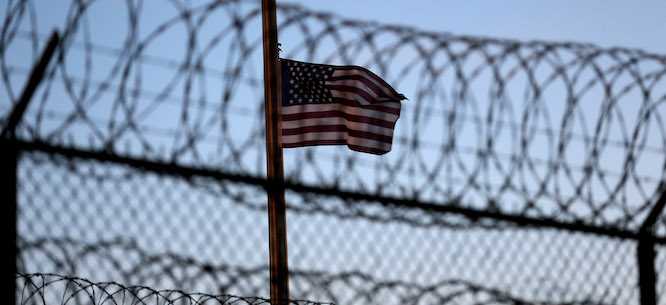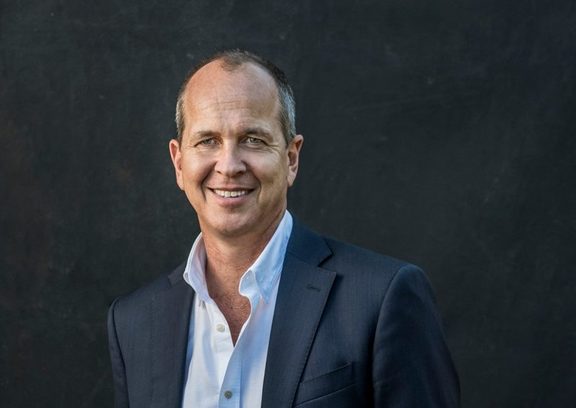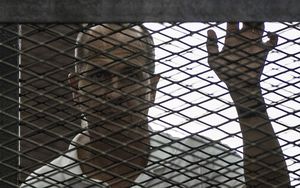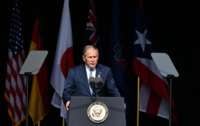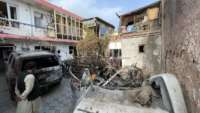On Wednesday, United Nations Secretary-General António Guterres warned Afghanistan is facing a “dramatic humanitarian crisis,” and urged foreign governments and institutions to keep supporting the people of Afghanistan. UNICEF has warned a million Afghan children are at risk of starvation.
We go now to the capital, to Kabul, where we’re joined by Anand Gopal. His latest article, “The Other Afghan Women,” appears in The New Yorker. It’s based on his deep reporting in the rural villages of Afghanistan that have been devastated by decades of war. Anand Gopal is also the author of No Good Men Among the Living: America, the Taliban, and the War Through Afghan Eyes.
Anand, thanks so much for joining us. Can you talk about who the “other Afghan women” are?
ANAND GOPAL: Thanks, Amy.
You know, when we were watching the images streaming from Kabul of people desperately trying to get to the airport, including many of my friends, you know, it was easy to come to the conclusion that perhaps what was happening right now was the worst thing that had happened in the last two decades. And, of course, there were many Afghans who wanted to get out because they desperately want a better life, and I don’t blame them for that.
There was another reality, actually, at the same time that wasn’t really covered as much, and that was happening outside of Kabul in rural areas, where, for the bulk of the last 20 years, the war was actually being fought. So, we think of the War in Afghanistan as just happening in Afghanistan, but, actually, it wasn’t fought in most of the country. There was only particular provinces where the fighting was happening.
So, I visited Helmand province in southern Afghanistan, which is really the epicenter of the violence for the last two decades. And I wanted to see how women there, who had been facing roadside bombs and night raids and airstrikes — what they thought about the U.S. withdrawal. So, that’s the “other Afghan women” in the title. And so, the piece is actually about trying to get their views of how they looked at the American withdrawal after two decades.
NERMEEN SHAIKH: And, Anand Gopal, just to make clear, 70% — over 70% of Afghanistan’s population is rural, so we have, in a sense, a highly distorted view, because we hear about urban areas — and, in fact, not just urban areas, only Kabul, or principally Kabul. Now, among the people that you spoke to in one village, Pan Killay, a woman told you that a large number of her family, all civilians, had been killed in the last years. And you went and spoke to many other families in the village and found that, on average, every family had lost 10 to 12 family members during the war, the war that they refer to as the American War. Could you elaborate on what they told you?
ANAND GOPAL: Sure. So, the woman in question, her name is Shakira, and she’s a housewife who lives in a very small village in the valley of Sangin, which was one of the areas of the most intense violence over the years. And so, I had the opportunity to meet her and interview her a number of times. And, you know, I’m somebody who’s been covering this conflict for many years, and even I was taken aback by the sheer level of violence that people like her had gone through and had witnessed.
So, she lost, as you said, 16 members of her family. But what was remarkable or astonishing about this was that this wasn’t in one airstrike or in one mass casualty incident. This was in 14 or 15 different incidents over 20 years. So, there was one cousin who was carrying a hot plate for cooking, and that hot plate was mistaken for an IED, a roadside bomb, and he was killed. There was another cousin who was a farmer, who was in the field and had encountered a coalition patrol, and he was shot dead. Shakira told me his body was just left there like an animal. So, there were so many different instances.
So people were living — reliving tragedy again and again. And it wasn’t just Shakira, because I was interested, after interviewing her, to see how representative this was. So, I managed to talk to over a dozen families. I got the names of the people who were killed. I tried to triangulate that information with death certificates and other eyewitnesses. And so, the level of human loss is really extraordinary.
And most of these deaths were never recorded. It’s usually the big airstrikes that make the media, because in these areas there’s not a lot of internet penetration, there’s not — there’s no media there. And so, a lot of the smaller deaths of ones and twos don’t get recorded. And so, I think we’ve grossly undercounted the number of civilians who died in this war.
NERMEEN SHAIKH: And, Anand, one of the other women that you spoke to, Pazaro, said to you, “They are giving rights to Kabul women, and they are killing women here. Is this justice?” she said. I mean, in a sense, as you show in this piece, “The Other Afghan Women,” there are two different realities in Afghanistan — there are probably more, but with respect to the attitude towards the Taliban taking over the country. Could you talk about that? You’ve covered, of course, as you said, the war extensively over many, many years, from Kabul as well as elsewhere across the country.
ANAND GOPAL: Yeah, I mean, when we think about women’s rights in Afghanistan, we tend to think about the ability to go to school, to work, to have representation in Parliament. And these are real gains that were made in the last 20 years. But there are other women’s rights that aren’t talked about.
So, when I asked Pazaro or other women, you know, “What do you think about the claim that the U.S. was bringing women’s rights to Afghanistan?” they told me, you know, “We can’t walk outside without worrying if we’re going to get blown up. So, what right do — you know, how is that protecting our rights?” It’s also a part of women’s rights to be able to walk without fear, to be able to live. To live is a woman’s right, right? So, they had a very different conception of women’s rights, which was not that they rejected the aspiration for wanting to get educated or to wanting to have a public role, but they also didn’t want to be shot at or have their loved ones killed. And so, they had a very different conception.
And so, when I asked them about the claim that the U.S. was bringing women’s rights, they were very skeptical, and many of them were cursing the United States, saying, “They brought us nothing.” So, for example, like, one person said, “They were bringing rights to Kabul, and they were just bombing us here,” essentially. So, it’s a country that has different realities, and I think we need to be able to hold both of those realities in our head at the same time.
AMY GOODMAN: Anand Gopal, if you can talk about the empowering of warlords by the U.S. occupation? If you can tell us the story of Amir Dado and take that right through to a person who ended up at Guantánamo?
ANAND GOPAL: So, Amir Dado was a member of the mujahideen, which was the holy warriors or the rebels, the rural rebels, that were fighting against the Soviet occupation. The Soviet occupation was a brutal occupation that killed millions of people in Afghanistan, and so, naturally, people were rising up against it. But at the same time, some of these rebels were being supported by Pakistan, by Saudi Arabia, and especially by the CIA. And so, there was the creation of warlords or strongmen. There was never warlords in Afghan history until the start of the wars in 1979.
So, Amir Dado is one of these warlords. And he came to prominence in the Sangin Valley in the mid-’80s. He was a major drug trafficker. He was also somebody who held a religious court, and he basically acted the way we think the Taliban would act now. You know, he would make sure women stayed in the home. When people tried to marry for love, he would have them arrested. He kidnapped people. I mean, he was really considered a real brutal strongman.
When the Taliban emerged in the mid-’90s, the main reason they emerged was to fight against people like Amir Dado. So they came to the Sangin Valley and Helmand in early 1995, and they demobilized him, and he fled the country. And then, for the next few years, the Sangin Valley and places in southern Afghanistan were at peace. And so, that was the kind of perspective that a lot of the women there had, which is that they don’t like the Taliban, but they hated the warlords. And so, at least the warlords were gone, and they would accept that.
Then, when the U.S. invaded in 2001, they did something astonishing, which is that they brought those very same warlords back into the country. You know, they had a choice there. They could have tried to support local Afghans. They could have tried to help build a democracy, with the incredible yearning there is in Afghanistan for a better world. I mean, people like Shakira, the woman I profile in the piece, she wanted the U.S. to invade. She hated the Taliban, and she wanted the support. Instead, what the U.S. did is they brought people like Amir Dado back into the country. The reason they did that is because the U.S. never really cared about building a democracy in Afghanistan. The mission was always about counterterrorism. It was always about trying to find the, quote-unquote, “bad guys.” And so they brought these warlords back in who could be their partners.
And so, for the next two or three years, from 2001 until 2004, Amir Dado basically terrorized the Helmand countryside. Hundreds of people, maybe thousands of people, innocent people, were arrested. People were killed. There’s the multiple cases of people who were wrongfully accused of being Taliban members and sent to Guantánamo. There was essentially a one-sided war that was waged by the U.S. and its allied warlords, like Amir Dado, against the Afghan population in Helmand. And that, ultimately, is what led to the reconstitution of the Taliban by 2004.
AMY GOODMAN: I mean, you talk about Amir Dado suspected of being responsible for the killing of U.S. Staff Sergeant Jacob Frazier and Sergeant Orlando Morales in March of 2003, but he managed to point the finger at a Taliban member who ended up being sent to Guantánamo.
ANAND GOPAL: Yeah. I mean, this is just an example of the extraordinary chaos that was happening there and the ways in which these strongmen were using their access to the Americans to eliminate their enemies. So, what happened in this case was that the U.S. Special Forces went to meet some members of the Afghan government in Sangin, and Amir Dado, who was a U.S. ally, engineered an attack, an ambush, on U.S. troops. It killed two U.S. soldiers, Special Forces personnel. They were the first two U.S. soldiers who died in Helmand as a result of violent activity. And the U.S. themselves, internally, among the Special Forces, began to suspect that their own ally, Amir Dado, was the one who was behind the attack.
Nonetheless, Amir Dado took some — basically, some random guy who had nothing to do with the attack, who was an ex-Taliban who had surrendered and was sitting at home, took him, tortured him and then delivered him to the U.S. and said, “This guy here is the person who was the real culprit.” The U.S. sent him to Guantánamo. He spent three or four years in Guantánamo. And when I looked at the classified documents from Guantánamo, which were eventually released by WikiLeaks, you know, what was extraordinary in those documents was that the investigating judges and others knew that this person was innocent. They wrote in the documents that Amir Dado, the U.S. ally, was the one who actually sent — who was the one who actually conducted this ambush. But, nonetheless, this person languished in Guantánamo for three or four years. His case is not unique. This has happened hundreds of times across the country in those years.
NERMEEN SHAIKH: And, Anand, as you’ve pointed out in a recent interview with Reveal News, one of the effects of the way in which the U.S. supported these warlords and made them extremely wealthy is that they had an incentive to continue the war and an incentive to continue producing terrorists. Now, you mentioned earlier that Pakistan and Saudi Arabia — Pakistan, in particular — played a critical role in supporting the mujahideen during the Soviet occupation. Could you say more about the role of Pakistan in supporting the Taliban all of these years and what role you think the country will play, Pakistan will play, in the interim government, its relations to the people who have been appointed in the interim government by the Taliban?
ANAND GOPAL: Well, Pakistan supports the Taliban very closely. A number of the senior leaders of the Taliban were living in Pakistan, so the ISI, the Pakistani intelligence agency, was basically sheltering the senior Taliban leadership. There’s a very close working relationship there.
But it’s very important to understand the history here, which is that in 2001, when the U.S. invaded, the Taliban was defeated. You know, to a man, they basically either surrendered or, you know, escaped and ran away. So, there was, in 2002, no Taliban in Afghanistan. There was no resistance whatsoever. Al-Qaeda, as well, fled the country. They went mostly to Pakistan, and some of them to Iran. So you had thousands of U.S. troops on the ground in 2002 with a mandate to fight a war against terror, but with no enemy actually to fight.
And so, this was the context in which they began to incentivize the allied warlords to basically produce bad guys and enemies for them. They started to arrest these people and kill them. This created the insurgency. Once the insurgency was created — and this is now 2004 — then Pakistan got involved and tried to influence the insurgency for its own interests. Its own interest is, it basically views Afghanistan as its own backyard and doesn’t want Indian influence. And so, Pakistan’s role in Afghanistan has been a very malign role. But we shouldn’t lose sight of the fact that the ultimate cause of the War in Afghanistan was by the U.S., its actions in the early years.
AMY GOODMAN: I wanted to ask you about a part of the article that hasn’t gotten very much attention. Anand, you tweeted, “CIA-created Afghan death squads were evacuated before many American citizens.” Can you explain?
ANAND GOPAL: So, from the very beginning, the U.S. created these militias. As I mentioned earlier, warlordism and militias, that’s not something that’s natural to Afghanistan. It really emerged in the late 1970s, early ’80s, as a result of the war. In 2001, the U.S. really invented some of these, created some of these groups. So, there is a group called the Khost Protection Force, which was a CIA-created militia in the southeast of the country. There’s many groups like this around the country. And they were seen as the CIA’s closest allies in trying to fight the Taliban. And many, many innocent people, many, many civilians suffered as a result of this. And so, their methods were seen as extraordinarily brutal.
What happened with the evacuation last month was that these CIA death squads were essentially the ones that were one of the guards of the airport itself. And the reason they were there is, ultimately, they were going to be evacuated, as well. And it was a horrific scene. As I was talking to colleagues and friends who were on the ground, sometimes these death squads are shooting at crowds. Also, the Taliban wasn’t always letting people through. It was chaotic. But, ultimately, all of these death squads got evacuated. There are still American citizens here in Afghanistan today trying to get out, but the CIA militias are all out. They’re now living in the United States. And it’s not the first time this has happened. There have been other CIA-backed strongmen who have been living comfortably in the U.S. for the last decade or two decades. And so, this is kind of, I think, an indictment on what the CIA’s priorities are in terms of Afghan lives.
NERMEEN SHAIKH: And, Anand, before we conclude, if you could comment on the people the Taliban has appointed to serve in the interim government? You’ve said that what’s striking in the list is that the most powerful members of the Taliban, those who were running the insurgency in the last 20 years, have been excluded. What are the implications of this? You’ve said that this might create a shadow government.
ANAND GOPAL: Yeah, I think that, you know, when we see the Taliban Cabinet that was announced a few days ago, I mean, all of those figures in the Cabinet held similar positions in the ’90s. But, really, the powerful people in the movement, some of them were military commanders, others do have Cabinet positions, but they all kind of exist in what’s called a shura, a leadership shura, which is in Kandahar. That’s really who’s controlling the country. There’s a prime minister. He’s a longtime member of the Taliban. But I’m not sure how much power he actually has. The real power is behind behind the scenes.
And I think that’s tragic for Afghans, because that means even less accountability. The previous regime, that was here for 20 years, had very little accountability. There was elections, but those elections were mostly rigged. And a lot of the real decision-making was done behind the scenes. And I think there were some Afghans who were hoping that this would be a change. I think this is not going to be a change. It’s going to be further down the line of zero accountability and power being wielded behind the scenes.
AMY GOODMAN: Finally, I wanted to ask you — a main issue that you write about is the countryside versus Kabul. We know a lot more about what’s happening in Kabul. You write, “The Taliban takeover has restored order to the conservative countryside while plunging the comparatively liberal streets of Kabul into fear and hopelessness.” Can you end with that?
ANAND GOPAL: Well, you know, there was a lot of — there’s activists, women’s rights activists, you know, people who are part of civil society, etc., all of which only appeared in the last two decades, and only appeared because of the American occupation. And for people like that, this obviously is a lot of — they’re facing despair, and it’s very understandable. Many of them have been able to leave the country. Many are still stuck here in Kabul. And Kabul is a relatively liberal area compared to the countryside. And there are more freedoms for women here than there are in places like Helmand, where I visited. And the idea that the Taliban are going to impose the mores of Helmand onto Kabul, I think, is a tragedy, because it means that people who have enjoyed some freedoms for the last two decades are going to see them rolled back.
All of this, I think, didn’t have to be this way. The U.S. had the opportunity in the early years to negotiate with the Taliban, when they were much weaker. They had the opportunity to try to create an inclusive government. But instead they chose the path of war, and here’s where we are now. Nobody has really won from this. The people in the countryside are breathing a sigh of relief because there’s no war, but the people in the cities are terrified. Nobody is actually happy with the outcome. And that’s a tragedy.
AMY GOODMAN: Anand Gopal, I want to thank you so much for being with us, journalist and professor at Arizona State University. His article, “The Other Afghan Women,” is in The New Yorker magazine. We’ll link to it at democracynow.org. He is also author of the book No Good Men Among the Living: America, the Taliban, and the War Through Afghan Eyes.
Coming up, as the debate over a booster vaccine shot, a third shot, heats up in the U.S., calls are growing for global vaccine equity. Stay with us.


